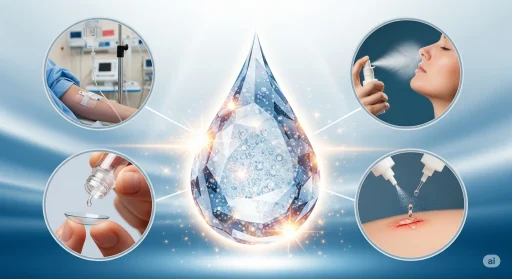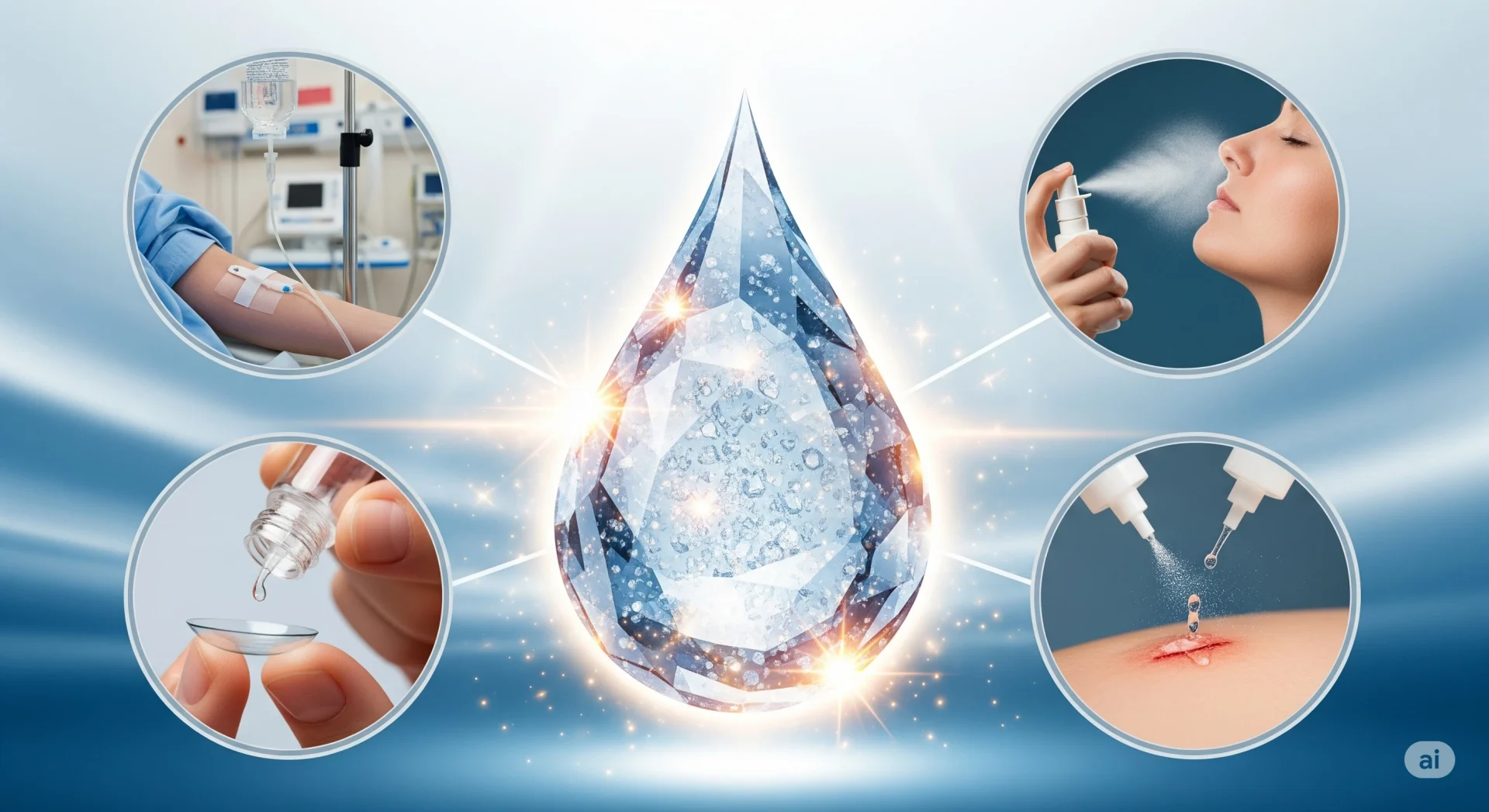For many, an unmistakable plastic bag stuffed with fluid, hung over an hospital bed, and the thin tube leading to the arm of a patient, is an enduring symbol of modern-day medical technology. This fluid is typically salicylate, a straightforward solution that has evolved into among the top essential and life-saving devices in the field of healthcare. However, the history of saline extends beyond the IV drip in hospitals. It’s available in first-aid kits to treat wounds as well as within our cabinets of medicine as nasal sprays and even on the counters in our bathrooms as a contact lens solution.
At its heart the saline mixture is made up made up of sodium chloride (NaCl)-table salt-and sterile water. However, it’s far from being merely saltwater. The real power and value of saline lies in the level. The amount of salt present in the water determines quality of the solution, the effect it has on human health, and also its purpose. Different amounts are utilized to provide basic cleansing to treating swelling of the brain.
Read More: IV Fluids & Injectable Medicines
This article will look into the fascinating world of solutions using saline. We will go over the fundamental science behind how saline interacts with body’s cells. We will also discuss the various kinds employed in daily life, and discuss the reason why this nebulous fluid is a real unsung the hero of wellness and health.

The Critical Science: Understanding Tonicity
To comprehend the various types of saline, it is necessary to first comprehend a fundamental biological concept: tonicity. Tonicity changes a cell’s size by controlling how water moves across its membrane. This motion, also known as Osmosis is the natural balance action.
Tonicity and Saline: How Solutions Shape Cell Survival
Imagine the cell as a small water balloon, whose exterior is an semipermeable membrane. The membrane permits water molecules to move without restriction, however it blocks larger molecules such as salt. Osmosis is the reason that water moves from an area that has the lowest concentration of substances (like salt) to an area that has more solutes, to try to balance the levels on both sides.
Our blood plasma and cell fluid both have about 0.9% salt. People use that level to judge the “tonicity” of a saline solution. If it matches, cells stay normal. If not, cells can shrink or swell.
- Isotonic Solution: The amount of salt within the solution remains the the same as that in cells (~0.9 percent). When a cell is placed in an isotonic solution, the water is able to move into and out at a similar rate. The cell is healthy and stable.
- Hypotonic Solution: In the hypotonic solution, salt concentration is less than that in cells (<0.9 percent). In a hypotonic state the water rushes through the cell in order to balance the increased salt content within. The cell will grow larger and eventually explode, which is a process known as hemolysis.
- Hypertonic Solution: In the hypertonic solution, salt concentration is greater than that in cells (>0.9 percent). Put a cell in a hypertonic solution, and water rushes out. The cell shrinks as water tries to balance things outside.
- The cell is then able to shrink and shrink, a process known as crenation.
This is that the proper dosage of saline for your needs isn’t only important, but also an issue of life and death in medical environments.
Read More: Glucose Saline Plant: How Entrepreneurs Can Launch Quickly with Pre-Engineered Solution
Types of Saline in Medicine
Medical Saline solutions are sterilized and are administered via intravenously (IV). They are classified by their tonicity, which determines the specific use in clinical practice.
Isotonic Saline: The Standard Workhorses
They keep your fluids balanced, so people trust and use them the most.
Normal Saline (NS or 0.9 percent NaCl): This is the most frequently utilized IV fluid in the world. It has 0.9 grams sodium chloride for 100 milliliters of water, which is a concentration that is not compatible with blood of a human.
Lactated Ringer’s Solutions (LR): Lactated Ringer’s isn’t just regular saline. Hospitals use it all the time. It contains sodium chloride, potassium, calcium, and sodium lactate.
Utilizes: This fluid matches your blood’s electrolytes better than Normal Saline. Your liver turns its lactate into bicarbonate, which helps fix mild metabolic acidosis. Doctors use it a lot during surgery and for treating burns or injuries.
D5W (5 percent Dextrose in Water): This solution is an original. In the IV bag it’s in isotonic. But once it is introduced into the body cells consume rapidly dextrose (a kind of sugar) to provide energy. The only thing left is water, which makes its effects to the human body the body hypotonic.
Utilization: Doctors use this for patients with high sodium (hypernatremia) because it gives free water and almost no calories. It’s not for regular rehydration since it lacks electrolytes.
Read Our Book: Click Here
Hypotonic Saline: Putting Water into Cells
These solutions have less salt than your cells. People use them to rehydrate the cells directly, not just the blood.
Half-Normal Saline (0.45 0.45 % NaCl): As the name implies, this has only half the salt content of Normal Saline.
Utilization: It treats severe cell dehydration, like in DKA, after isotonic fluids. It moves water from the bloodstream into dried-out cells.
Warning: Be careful with hypotonic solutions. Give them too fast and red blood cells can swell and burst. Even worse, brain cells might soak up fluid and cause dangerous brain swelling.

Hypertonic Saline: Pulling Water Out of Cells
These are solutions that contain high-concentration saline utilized in emergencies of critical care to quickly flush out water of cells that have swollen.
3 % NaCl and 5 percent NaCl Saline The solutions are the salt concentration of three to five times greater than the blood of a human.
Uses:
Severe Hyponatremia It is used to treat those with extremely low sodium levels, that can trigger seizures and coma.
Cerebral Edema When there is a traumatized brain injuries or neurosurgery procedures, the brain could expand. Hypertonic Saline is used to remove excess fluid from the swelling brain cells and into the bloodstream. This reduces the pressure inside the brain.
Warning: These are high-alert medication. They should be administered within the ICU setting, usually via an intravenous line with a steady, controlled infusion rate and constant checking for the blood chemical levels to prevent adverse side effects that can be dangerous.
Read Our Project: Click Here
Saline Beyond the IV Bag: Everyday Uses
Saline’s value extends beyond the confines of a hospital.
- Nasal Sprays as well as Rinses: The nasal saline that is available over the counter generally is an isotonic (0.9 percent) solution. It’s used to moisten dry nasal passages, reduce mucus and eliminate allergens and irritations, thereby easing allergies and congestion.
- Contact Lens Solution The solution is buffered, safe and isotonic solution specifically designed for eyes. It’s used to rinse and rehydrate and then keep soft contact lenses in storage. It is important to only make use of commercially-prepared contact lens solution. Because DIY versions aren’t sterilized and could cause serious eye infections.
- Piercing Care Aftercare Professional piercers suggest sterilized isotonic saline to clean new piercings. It’s the most gentle and most secure option, since it cleanses the area without damaging the delicate healing tissue. It is not as harsh as antiseptics, such as hydrogen peroxide or alcohol.
Want To Know About Which Business Idea Would Be Better For You?
Go Through Our Startup Selector Tool
Conclusion
From a life-saving dose in the Intensive Care Unit to a soothing spray for the nasal to treat a common cold the saline solution proves to the efficacy of a simple, effective medication. It’s an excellent illustration of how a simple substance, if properly formulated it can produce profoundly various and crucial impact on human health. The key to success, as we’ve discovered is concentration. Knowing the science behind tonicity enables healthcare professionals to utilize isotonic solutions that gently replenish hydration hypotonic solutions that carefully replenish cells and hypertonic solutions for emergencies. In all its forms the saline is a vital yet versatile hero that quietly assists in promoting life and health each day.
Types Of Saline: Frequently Asked Questions (FAQ)
Q1 How can me make my own solution for saline at home?
To make a basic nasal rinse, dissolve a teaspoon of non-iodized salt in a cup of boiled, cooled water. This mix isn’t sterile, so never use it for wounds, contacts, or anything besides your nose.
Q2 What is the reason it’s dangerous to drink seawater when I’m dehydrated?
Seawater has way more salt than your cells. Drink it, and your body yanks water from your cells to even out the salt. You get more dehydrated, not less. It’s a terrible way to quench your thirst.
Q3: What’s what is the distinction between Saline solution and the solution saline?
There is no distinction. The terms are interchangeable to describe the solution of sodium chloride in water.
Q4 is saline better than water and soap to clean cuts?
In the beginning, to clean the minor wound, a gentle wash using mild soap and water can remove dirt and bacterial. In the event of cleaning or irrigating an injury, sterilized Saline is typically preferred because it’s less irritating for the wound’s healing skin than soap.







